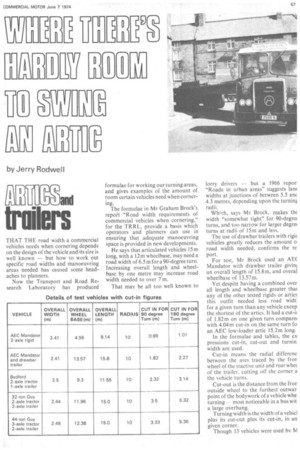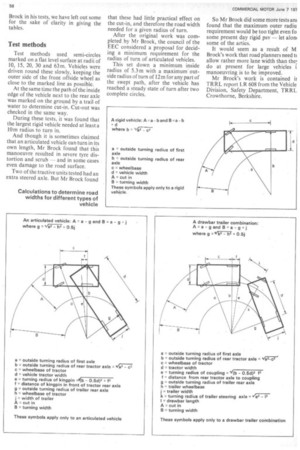N 3
Page 59

Page 60

If you've noticed an error in this article please click here to report it so we can fix it.
trailers
THAT THE road width a commercial vehicles needs when cornering depends on the design of the vehicle and its size is well known — but how to work out specific road widths and manoeuvring areas needed has caused some headaches to planners.
Now the Transport and Road Research Laboratory has produced formulae for working our turning areas, and gives examples of the amount of room certain vehicles need when cornering.
The formulae in Mr Graham Brock's report "Road width requirements of commercial vehicles when cornering," for the TR R IL, provide a basis which operators and planners can use in ensuring that adequate manoeuvring space is provided in new developments.
He says that articulated vehicles 15 m long, with a 12m wheelbase, may need a road width of 6.5 m for a 90-degree turn. Increasing overall length and wheelbase by one metre may increase road width needed to over 7 m.
That may be all too well known to lorry drivers — but a 1966 repor "Roads in urban areas" suggests lane widths at junctions of between 5.5 anc 4.3 metres, depending upon the turnirq radii.
Whicth, says Mr Brock, makes the width "somewhat tight" for 90-degree turns, and too narrow for larger degree turns at radii of 15m and less.
The use of drawbar trailers with rigic vehicles greatly reduces the amount o road width needed, confirms the re port.
For test, Mr Brock used an AE( Mandator with drawbar trailer givim an overall length of 15.8 m, and overal wheelbase of 13.57m.
Yet despite having a combined over all length and wheelbase greater thai any of the other tested rigids or allies this outfit needed less road widt: for a given turn than any vehicle excep the shortest of the artics. It had a cut-ii of 1.82m on one given turn compare( with 4,04m cut-in on the same turn fo an AEC low-loader artic 15.2m long.
In the formulae and tables, the ex pressions cut-in, cut-out and turnin width are used.
Cut-in means the radial differenc between the arcs traced by the fron wheel of the tractive unit and rear whee of the trailer, cutting off the corner a the vehicle turns.
Cut-out is the distance from the fror outside wheel to the furthest outwar point of the bodywork of a vehicle whe turning most noticeable in a bus wit a large overhang.
Turning width is the width of a vehicl plus its cut-out plus its cut-in, in an given corner.
Though 13 vehicles were used by M Brock in his tests, we have left out some for the sake of clarity in giving the tables.
Test methods
Test methods used semi-circles marked on a flat level surface at radii of 10, 15, 20, 30 and 63m. Vehicles we're driven round these slowly, keeping the outer side of the front offside wheel as close to the marked line as possible.
At the same time the path of the inside edge of the vehicle next to the rear axle was marked on the ground by a trail of water to determine cut-in. Cut-out was checked• in the same way.
During these tests, it was found that the largest rigid vehicle needed at least a 10 m radius to turn in.
And though it is sometimes claimed that an articulated vehicle can turn in its own length, Mr Brock found that this manoeuvre resulted in severe tyre distortion and scrub -and in some cases even damage to the road surface.
Two of the tractive units tested had an extra steered axle. But Mr Brock found that these had little practical effect on the cut-in, and therefore the road width needed for a given radius of turn.
After the original work was completed by Mr Brock, the council of the EEC considered a proposal for deciding a minimum requirement for the radius of turn of articulated vehicles.
This set down a minimum inside radius of 5.3m with a maximum' outside radius of turn of 12 m for any part of the swept path, after the vehicle has reached a steady state of turn after two complete circles, So Mr Brock did some more tests ant found that the maximum outer radiu requirement would be too tight even fo some present day rigid psv let aloni some of the artics.
It would seem as a result of M Brock's work that road planners need t( allow rather more lane width than the! do at present for large vehicles i manoeuvring is to be improved.
Mr Brock's work is contained it TR RL report LR 608 from the Vehicle Division, Safety Department, TRRL Crowthorne, Berkshire.




























































































































































